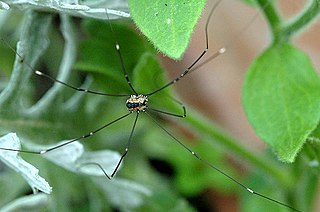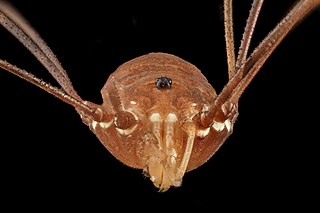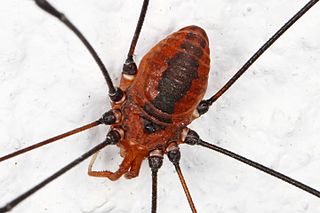
The organ pipe mud dauber is a predatory wasp in the family Crabronidae. They are fairly large wasps, ranging from 3.9–5.1 cm, and have been recorded to fly from May to September. Female and male are similar in colour, a shiny black with pale yellow to white hind hindtarsomere. The organ pipe mud dauber feeds mainly on three genera of spider: Neoscona, Araneus, and Eustala. Melittobia, a parasitoid wasp, is a common ectoparasite of T. politum prepupae. Other sources of parasitism include the Bombyliid fly Anthrax, Chrysidid wasps, and various species of scavenger flies (Miltogramminae). The tufted titmouse is a known predator of T. politum, and may feed on them more commonly than previously thought as the holes made by the titmouse are similar in shape and size to those made by T. politum leaving the nest after pupation.

Leiobunum is a genus of the harvestman family Sclerosomatidae with more than a hundred described species. Contrary to popular belief, they are not spiders, although they share a resemblance. They are arachnids, in the order Opiliones, harvestmen. Species in Leiobunum tend to have relatively long legs compared with other harvestmen, and some species are gregarious.

Leiobunum rotundum is a species of harvestman. It is found in the western Old World.

The subfamily Crabroninae(digger wasps) is the most diverse group in the wasp family Crabronidae, containing over 110 genera and 4,800 described species. The subfamily consists of solitary, predatory wasps. The adult females of many groups dig tunnels in the ground for nesting, but others use different techniques, including the construction of tube-like mud nests.
Entoloma politum is a species of fungus in the Entolomataceae family. It is found in Europe and North America.
Leiobunum townsendi is a species of harvestman in the family Sclerosomatidae. It is found in North America.

Gnathium is a genus of blister beetles in the family Meloidae. There are about 16 described species in Gnathium.
Leiobunum bracchiolum is a species of harvestman in the family Sclerosomatidae. It is found in North America.
Leiobunum ventricosum is a species of harvestman in the family Sclerosomatidae. It is found in North America.
Leiobunum bimaculatum is a species of harvestman in the family Sclerosomatidae. It is found in North America.
Leiobunum crassipalpe is a species of harvestman in the family Sclerosomatidae. It is found in North America.

Leiobunum nigropalpi is a species of harvestman in the family Sclerosomatidae. It is found in North America.
Leiobunum relictum is a species of harvestman in the family Sclerosomatidae. It is found in North America.

Leiobunum flavum is a species of harvestman in the family Sclerosomatidae. It is found in North America.

Leiobunum vittatum is a species of harvestman in the family Sclerosomatidae. It is found in North America.

Leiobunum aldrichi is a species of harvestman in the family Sclerosomatidae. It is found in North America.

Leiobunum calcar is a species of harvestman in the family Sclerosomatidae. It is found in North America.
Leiobunum euserratipalpe is a species of harvestman in the family Sclerosomatidae. It is found in North America.

Leiobunum verrucosum is a species of harvestman in the family Sclerosomatidae. It is found in North America.
Leiobunum uxorium is a species of harvestman in the family Sclerosomatidae. It is found in North America.









